“Butterflies are not insects,’ Captain John Sterling said soberly. ‘They are self-propelled flowers.”
Robert A. Heinlein, The Cat Who Walks Through Walls
Everyone knows that butterflies are the most brightly coloured of insects. But why are they so colourful? And it’s important to remember that there are many grey, brown and green species. These are also colours, albeit dull ones – what is their significance?
I must state at this stage that there are many theories as to why butterflies have evolved the colours they have. This is not the kind of article to debate the pros and cons of these theories! All I can do, is to describe what exists, and offer some possible explanations.
The colours and patterns on a butterfly’s wings (and on moths’) are made up of many thousands of tiny scales. These are attached to the wing surfaces by microscopic ball and socket joints, and there is usually more than one layer of scales one on top of another. Each scale is individually coloured, and together they make up the patterns on the butterflies’ wings. The idea for the pixels that make up the images on the computer screen you are looking at, came from this!
Underneath, the wings are as clear as those of a fly’s.
It might help to categorise butterfly colours.
Reds, oranges and yellows with black

Acraea acara male Acara Acraea
Red is the colour of danger, as we know. And there are many red butterflies. Here’s one example, the Acara Acraea, Acraea acara acara. This butterfly’s larva feeds on Passifloraceae, whose cells are loaded with cyanogenic glycosides. This is an adaptation to deter herbivores – and the Acara Acraea’s larvae can digest these chemicals and turn them to their own defence. The toxins are carried through to the adults, which have developed the so-called ‘Aposematic colouration’ – warning colours – to deter their predators. Most birds will spit out any Acraea they catch… but not always. Bee-eaters and Cuckoos seem to be able to deal with the cyanide that they are able to spurt out when wounded.

Acraea petraea male Blood Red Acraea

Telchina igola female Dusky Veined Acraea
Kloof is particularly blessed with fire-engine red butterflies. Blood Red Acraea larvae feed on African Dog-rose Xylotheca kraussiana, and Dusky-veined, on Climbing Urera, Urera trinervis. Both are common local plants, so these butterflies are easy to attract to your garden.

Pseudacraea boisduvali trimeni f colvillei Boisduvals False Acraea
Here’s another VERY red butterfly. Boisduval’s False Acraea, Pseudacraea boisduvali trimeni, is like an Acara Acraea on steroids – it’s bigger and more striking. It shares the Acraea’s high, slow flight. And yet, its larvae feed on non-toxic plants such as Natal Milkplum, Bequaertiodendron natalense. This is a classic example of what we call ‘Batesian mimicry’, where edible species gain protection from predators by resemblance to something they avoid.

Telchinia cabira Yellow Banded Acraea
Yellow and black is another reputed indicator of distastefulness. An example of this patterning is the Yellow Banded Acraea, Telchinia cabira. However, this butterfly and its close relatives use Triumfetta rhomboidea as a larval host plant. This does not have a record of toxicity – in fact, its leaves have a long history of use as a food for humans. Clearly, something complicated is happening here!
Some of our smaller butterflies sport fiery red livery. The Common or Eastern Scarlet, Axiocerses tjoane, is a good example. The males look like tiny glowing embers as they whizz around a hilltop. Fortunately for photographers, they are widespread, don’t fly too high, and love to show off…

Axiocerses tjoane male Eastern Scarlet
This one is sitting in the favoured position, head down, wings akimbo, facing the world. Can you see the false eye and antennae at the tail of the hind wing?

Pardopsis punctatissima male Polka Dot
Polka Dot is a grassland butterfly in the subfamily Heliconiinae (which contains the genus Acraea) whose larvae use Hybanthus capensis (Violacaea). This is another plant genus known to carry toxins. Like its relatives it is a slow flying creature that seems not to care if it gets caught and injured. And now it’s time to introduce something that isn’t a butterfly…

Zerenopsis lepida Leopard Magpie
Leopard Magpie is a diurnal moth from the family Geometrinae. It has very similar colouring to the Polka Dot, and often flies with it. Its larvae eat the leaves of cycads – which carry the toxin cycasin. This is a carcinogen, but it also has acute toxicity effects – and somehow these ‘cycad moths’ are able to metabolise and use them to defend themselves. This is an ancient moth family – and many are diurnal, like butterflies. Some of today’s experts are wondering if bright colouration, diurnal behaviour and toxicity all co-evolved at the same time in prehistory, Perhaps at one time, all ‘butterflies’ were simply brightly coloured Lepidoptera that became diurnal in order to escape nocturnal predators.

Kedestes macomo male Macomo Ranger
The ‘yellow-with-black-spots’ colour pattern even carries across into grass-feeding species like the Skippers. This Macomo Ranger has a conspicuous underside. Perhaps predators avoid it because they fear it may be a nasty tasting Leopard Magpie…? there are many lepidoptera with this wing pattern, and such common patterns are called ‘mimicry rings’. There used to be two recognised forms of mimicry – Batesian, in which palatable species mimic distasteful ones, and Muellerian, in which distasteful species evolve to look alike in order to ‘dilute’ the effects of the Batesian ones. But it isn’t as simple as that – for a start, there is no conscious decision by these insects to look alike. It is all driven by natural selection.
Black and white (or pale blue)

Amauris ochlea male Novice ups alkaloiding on Heliotropium
Another ‘mimicry ring’ is that of black-and-white butterflies. There are many of these. It’s pretty much accepted that the pied markings of Danaine species like the Novice are an advertisment of distastefulness. These butterflies’ larvae feed on members of the plant family Asclepiadaceae, some of whose cells contain cardiac glycosides – heart poisons. The larvae are conspicuous and one might expect that they have metabolised the poisons. But many Asclepiad plants are non-toxic; indeed, rural African people use them as spinach. So any larva eating them might be expected also to be non-toxic. Yet the butterflies are almost always distasteful to birds. Why?
The answer lies in this picture. This male Novice is sucking up juices from an injured Heliotropium plant. Such plants exude toxic, bitter tasting pyrrolizidine alkaloids when attacked by herbivores, as a defense mechanism. The male butterflies have been shown to be able to metabolise these alkaloids and create their own bird-scaring toxins from them, as well as pheromones to attract females.
Butterflies from the Danainae (Monarch-types) are not the only Lepidoptera to do this. Many moth species also ingest these alkaloids. Like this one:

Amerila bauri Bauer’s Frother
There are many black-and-white butterflies that are definitely not toxic, such as the female Mocker Swallowtail, Papilio dardanus cenea:

Papilio dardanus cenea f hippocoonides Mocker Swallowtail female
And the female Forest Queen, Charaxes wakefieldi:
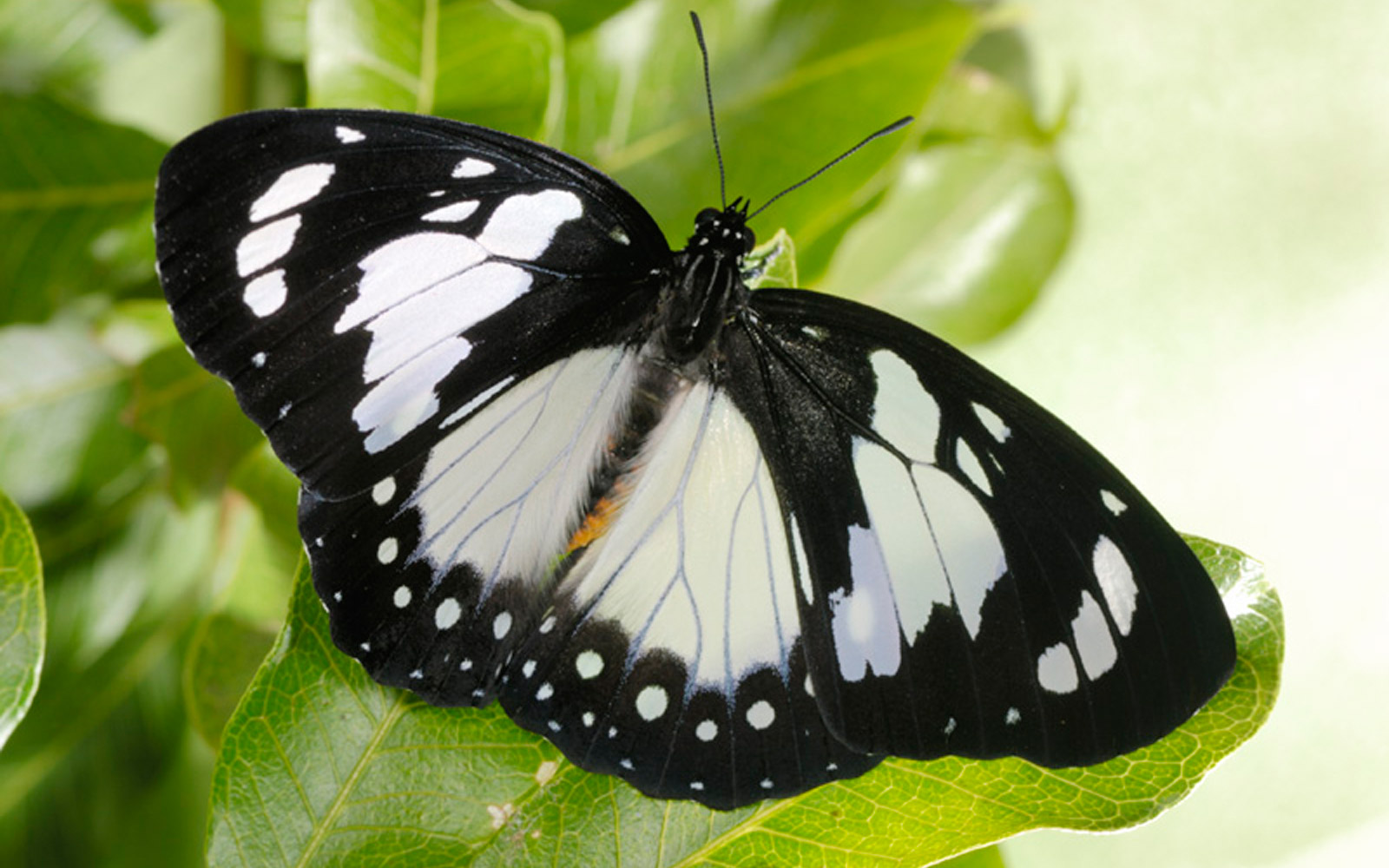
Charaxes wakefieldi female Forest Queen
In fact, when you start to delve into this, you realise that there are so many different black-and-white butterflies and moths. Which are distasteful and which aren’t? Well we are not exactly sure. Is mimicry a simple matter of protective resemblance? Consider these species:

Charaxes wakefieldi male Forest Queen

Graphium leonidas leonidas female Veined Swordtail
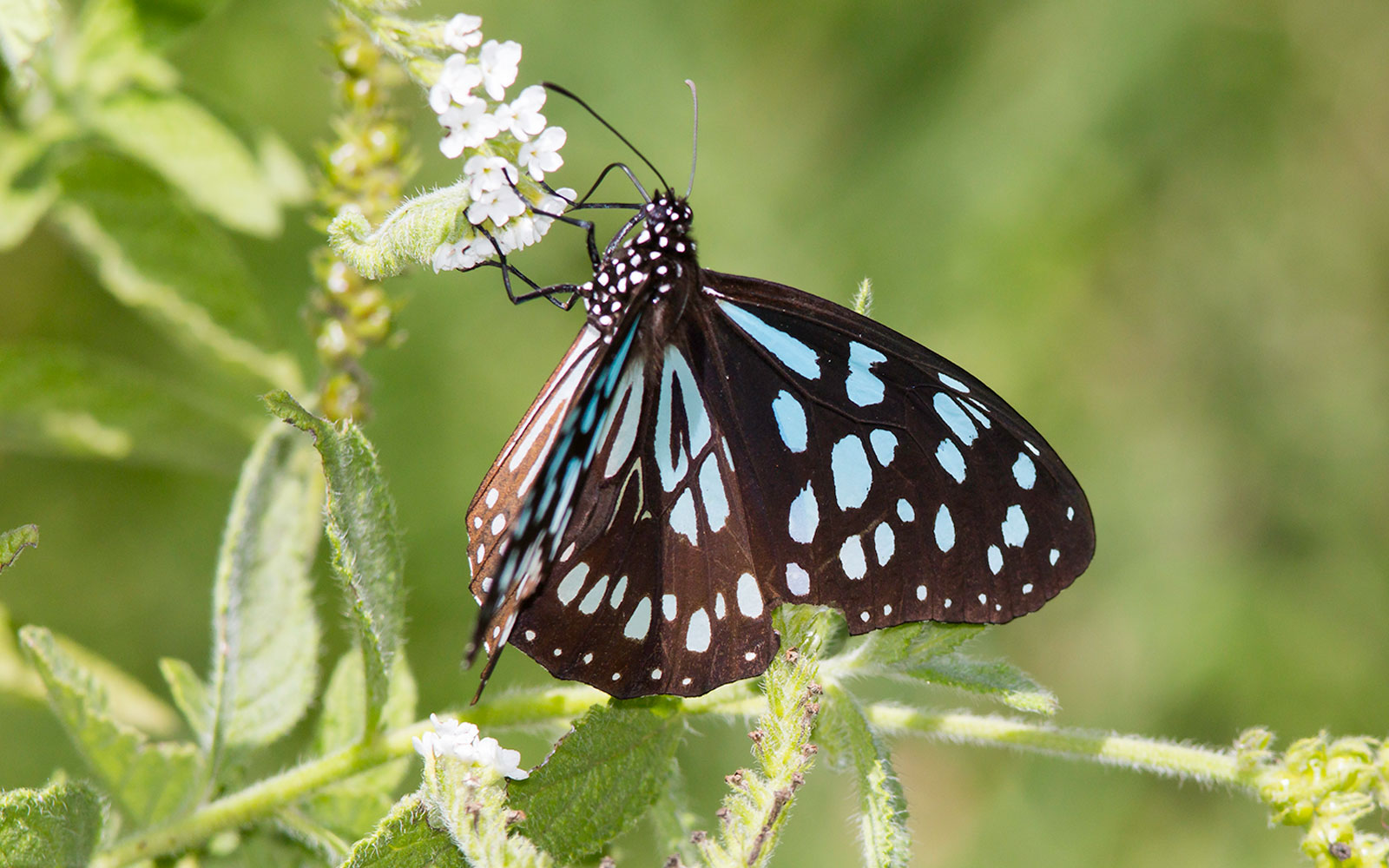
Tirumala petiverana male Blue Monarch
These are all black butterflies with pale blue or white spots and streaks. Palatable Forest Queen and Veined Swordtail are both found in South Africa, quite commonly. Distasteful Blue Monarch is almost never found here – there are only two or three records, although it’s common further north in Africa. If colour and pattern similarity was an indicator of protective resemblance, surely the palatable species would not be found here?
White or yellow to orange, with some black
Moving away from the tales of poisoners and fake poisoners, we can now look at the classical ‘butterflies’. The name originated in England. In no other language are they called this. In France they are called ‘Papillon’ – which probably stems from the Latin ‘papilio’ for ‘tent’ or ‘butterfly’ – the word ‘Pavilion’ has the same origin. In German – ‘Schmetterling’. In Spanish – ‘Mariposa’. It goes on. It’s thought that the origin in English is ‘butter-coloured fly’; the earliest butterflies to emerge after winter in England are pale yellow. Perhaps this was considered a sign that after winter, cows were producing milk and butter was on the menu again. Who knows?
Those English spring butterflies are in the family Pieridae – which almost has the monopoly on white, yellow or orange colours. Patterns are usually in black, but this is rarely the dominant colour. Pierid butterflies are very conspicuous in Africa; the best-known being the migratory Brown-veined White, Belenois aurota:
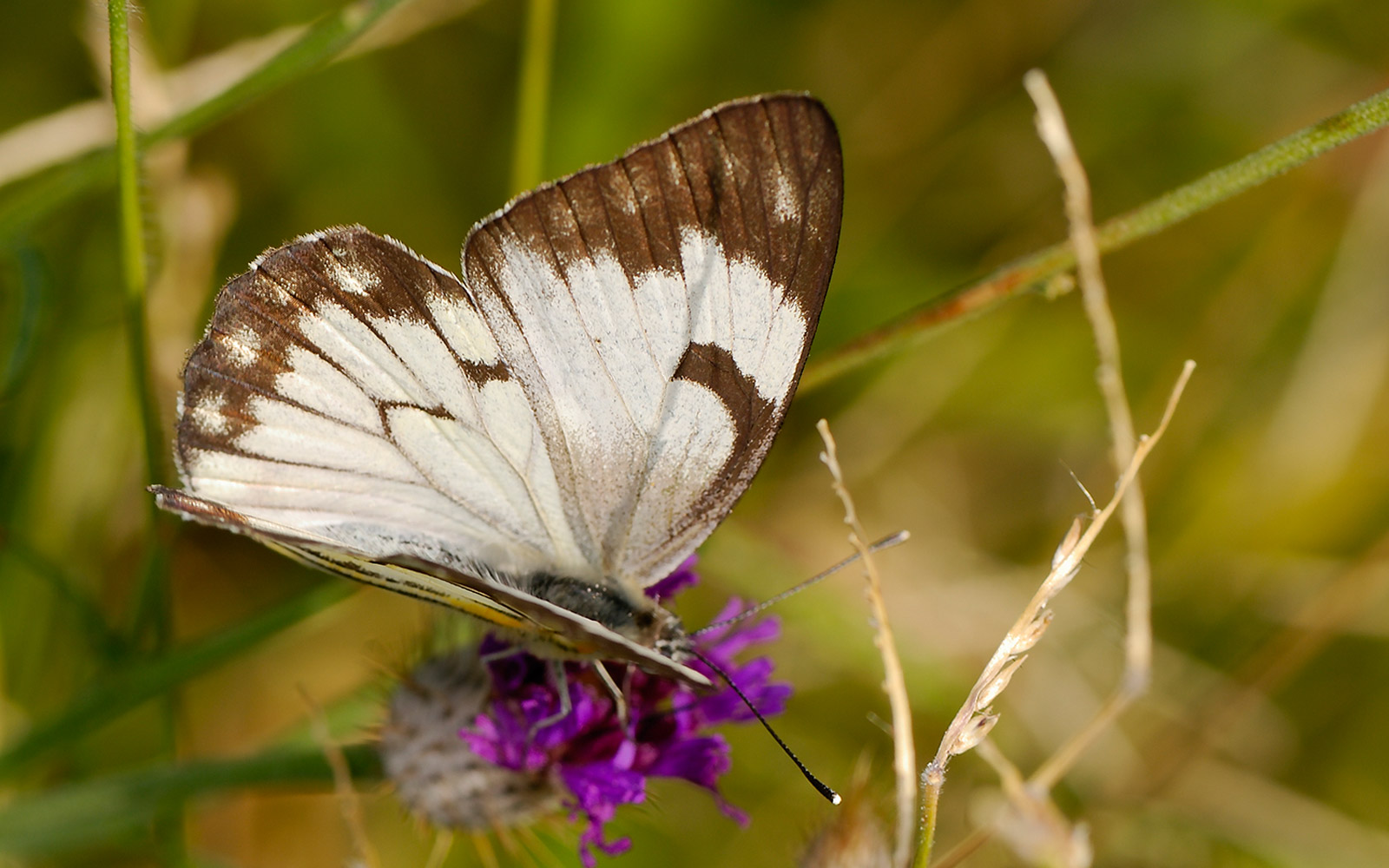
Belenois aurota female Brown veined White
Some of our most brightly coloured butterflies are in this family… like this male Autumn-leaf Vagrant or Orange-and-Lemon, Afrodryas leda, a large and conspicuous butterfly.

Afrodryas leda male Autumn leaf Vagrant
Some have glorious purple wing tips, like this Queen Purple Tip Colotis regina:

Colotis regina male Queen Purple Tip
And some have spectacular combinations of white and orange, like this male Twin Dotted Border, Mylothris rueppellii haemus:

Mylothris rueppellii haemus male Twin Dotted Border
We are not too sure what natural selection pressures drive these colours. They are possibly to do with sexual signalling. We do know that they come from pigments called Pterins, which are derived from Uric acid. We also know that Pierid larvae feed on plants containing irritant chemicals – such as Capparaceae (Caper family) and Loranthaceae (Mistletoes), but the adults are often seen being eaten by birds, so the protection value of their colouration is doubtful.
Also, many female Pieridae adults have colours that are only visible in UV light. The undersides reflect these colours, and are exposed to the males when they are receptive to mating. The female sits wings-closed. If unreceptive, the female holds her wings flat open, abdomen pointing straight. This hides the UV reflective surface of the underside; only the upper side is visible to the male. These Twin Dotted Borders show this behaviour well:

Mylothris rueppellii haemus female Twin Dotted Border rejecting male advances
Sandy, earth colours, dead leaves, lichen, bird droppings etc.
Many butterflies are NOT brightly coloured, at least not all over. There are many examples whose undersides are very cryptic, such as this Worcester Copper Aloeides lutescens:

Aloeides lutescens male Worcester Copper
The upper side is pale copper, but this is seldom seen because the butterfly is reluctant to open its wings when settled. When resting on sandy ground it is almost invisible.
Dead-leaf mimics are numerous among the butterflies. One of the best examples is the Dead-leaf Commodore Precis tugela. Its upper side is a striking orange-banded brown, but the underside looks just like a dead leaf. No two individuals are alike.

Precis tugela tugela male Dead-leaf Commodore upper side

Precis tugela female Dead-leaf Commodore variegated underside

Precis tugela tugela male Dead-leaf Commodore flat underside
These are examples of mimicry, where the butterfly gains protection by resembling its background. Another example that is special to South Africa are the Rocksitter butterflies. As their name implies, they sit on rocks. The rocks are covered in lichens and the butterflies’ hind wing undersides make them seem to disappear against the background.

Durbania amakosa flavida male Yellowish Amakosa Rocksitter
Rocksitters live in small colonies amongst suitable rocks; some, like the Yellowish Amakosa Rocksitter Durbania amakosa flavida, are rare and localised. Their larvae eat cyanobacteria off the rocks, and the adults are distasteful; if handled they exude a bitter liquid. The underside fore wings and upper sides are brightly marked in black-and-red or -orange, and when disturbed they expose them, as in this male Whitish Amakosa Rocksitter, Durbania amakosa albescens.

Durbania amakosa albescens male Whitish Amakosa Rocksitter
Another strategy is to resemble something inedible, like this Buff-tipped Skipper, Netrobalane canopus. The resemblance to a bird dropping, even to the smeared, semi-transparent parts, is uncanny. This is a common type of mimicry among moths as well.

Netrobalane canopus male Buff-tipped Skipper
Eyespots
Eyespots are another type of pattern often seen in butterflies. There are many theories as to why these are so prevalent. One of the most popular is that their resemblance to eyes startles small predators such as birds, lizards and rats. The subfamily in which they are most often seen is Satyrinae, otherwise known as the Browns, or Ringlets – the latter, from the number of species that show spectacular eyespots. And most of them are brown in colour. Here are some examples:
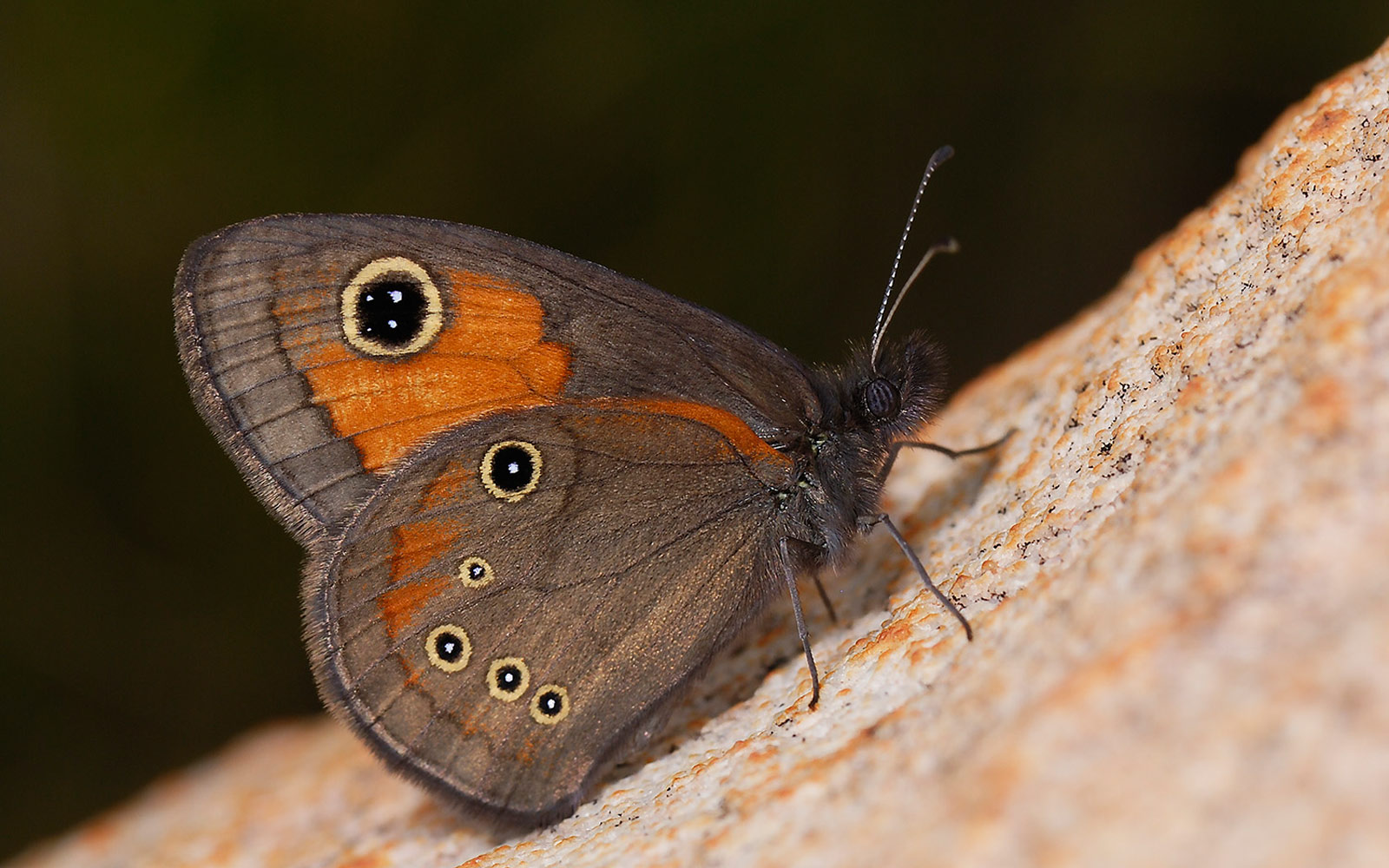
Paternympha narycia male Spotted-eye Brown
Spotted-eye Brown Paternympha narycia is a small grassland butterfly with beautiful golden eyespots on a grey-brown and orange ground. It’s only about 25mm across, and is quite inconspicuous until you get close.

Dira oxylus female Pondoland Widow
Pondoland Widow Dira oxylus is one of the larger brown butterflies. Widows are unique to South Africa – there are several species in more than one genus. This one flies in huge numbers in suitable grasslands in southern KZN and the Eastern Cape. The females have some of the most spectacular eyespots of all the Satyrinae.

Junonia orithya female Eyed Pansy
Big eyespots are not restricted to the Satyrinae. The Eyed Pansy, Junonia orithya madagascariensis, is a gorgeously coloured member of the Nymphalinae with large prominent eyespots. The female, shown here, has the larger spots and often sits wings-open, displaying them.
Copper and gold
Now we come to some really bold colours. South Africa is home to many shiny copper coloured butterflies. Most are related to the Eastern Scarlet shown above. This female Natal Opal, Chrysoritis natalensis, shows how the metallic copper shifts to gold at certain angles. These little butterflies are intensely territorial like the Scarlets, and are found close to clumps of their host plant, Tick-berry Osteospermum moniliferum. The colours are not formed by pigments, but by microscopic, shiny thin layers of chitin, the protein-polysaccharide composite that all insects (and fungi – would you have guessed?) are made of. These are stacked up on the wing scales so that they refract and reflect coloured light.

Chrysoritis natalensis female Natal Opal
Less brilliantly coloured, and much more reluctant to open their wings, are the Rough Coppers (genus Aloeides). This male Pennington’s Copper Aloeides penningtoni broke the rules recently at Vernon Crookes Nature Reserve on the South Coast.

Aloeides penningtoni male Pennington’s Copper
Rough Coppers sometimes have sandy, cryptic undersides like the Worcester Copper shown above, but they also often have bright magenta hues like this Aranda Copper, Aloeides aranda:

Aloeides aranda female Aranda Copper
This butterfly has several colour forms, most of which are grey or brown underneath, but occasionally one finds a shocking pink one like this. They sit on the ground like the dull coloured ones, as if they expected to blend in like they do – but to our eyes they stand out somewhat!
Brilliant, reflective metallic blues, greens
The metallic blue butterfly might be seen as one of nature’s clichés, but clichés exist for a reason – they are a sign of popularity! In South Africa we have many lovely blue or green butterflies, too many to show here – and it’s hard to choose which to show here!
The classic ‘blue’ butterfly is a member of the Lycaenid subfamily Polyommatinae. Our ‘Blues’ vary in size from minuscule to medium sized.

Lepidochrysops patricia male Patrician Blue
This male Patrician Blue, Lepidochrysops patricia, is one of the largest ‘true’ Blues found in South Africa. This one apologises for encouraging an invasive alien plant, Lantana camara. Sadly, butterflies are no respecter of ‘no aliens’ policies! As long as the nectar is abundant and sweet, that’s all they care about.
We have a group of butterflies that combine the best of the coppers and the blues. ‘Opals’ are among my absolute favourite butterflies. I used to say they can’t make up their minds if they are coppers or blues! Here’s a good example, Common Opal Chrysoritis thysbe thysbe from Cape Town. Opals are found all over the fynbos and karoo areas, even on the high peaks of the Drakensberg.

Chrysoritis thysbe thysbe male Common Opal
As with the related Natal Opal, when the sun catches the wing bases they light up in hues of green and purple – hence the name ‘Opal’.
Large blue butterflies are quite numerous as well. Many of the Charaxes are blue, especially the males, like this Blue-spotted Charaxes Charaxes cithaeron cithaeron from my garden in Gillitts:

Charaxes cithaeron cithaeron male Blue-spotted Charaxes
The most iconic large blue butterfly we have is confined to the coastal forests of Northern KZN and Zululand. Gold-banded Forester, Euphaedra neophron neophron, is a member of a large butterfly genus found all over tropical Africa. There are nearly 250 species, all of which are brilliantly coloured, but we have only one. Luckily it’s one of the brightest!

Euphaedra neophron male Gold banded Forester
These beauties are great fun to watch and (try to) photograph. They fly low, wings open, along forest paths. They love rotten fruit and chewed up sugar cane, so it’s not difficult to find them.
Green butterflies are not very numerous in South Africa. Our best example is a rare inhabitant of the same northern forests as the Gold-banded Forester. Mottled-green Nymph Euryphura achlys can sometimes be found in the Kosi Bay to Tembe Elephant Park area; recently one was photographed at Lekgalameetse Nature Reserve in Limpopo. They have been seen on two occasions in Ongoye Forest reserve. Further north in Africa they are commoner – sometimes extremely so. But here they have always been rare.

Euryphura achlys male Mottled-green Nymph
Ken Pennington, master at Michaelhouse, of Pennington’s Butterflies fame, was the first person to see one in South Africa, at Ongoye. His letter to David Swanepoel (my comments in brackets) about it ranks as one of the best bits of lepidopteralia…
‘I am just back from eight days collecting at the Ngoye (sic) forest between Eshowe and Empangeni. I think I told you I was sure it would hold some secrets, and even this short visit has proved my guess was right. We struck rather poor weather (so what’s new?) but worked hard every day when the sun shone. But what a job to get there. Six miles of fair road to a mission, four more of rough track made by a native car owner (this WAS 1952 remember…) and then five miles of grass, roughly following cattle tracks, dodging granite boulders and swamps (nothing has really changed…). We landed on three large stones, but I was travelling slowly and no harm was done. We had permission to stay in the Forest hut, had good water and considerable comfort. Now hold your breath! The first morning among the many Charaxes of the common sort in traps I took a perfect female Euryphura achlys… [later] three males and five females… What a surprise and what gems!… this will shake you. We were staggered, as you would have been…
‘But boy, see for yourself the bronzy green gloss of an achlys flying down a stream or along a glade, and you’ll die happy.’
This kind of sums up why people chase butterflies.
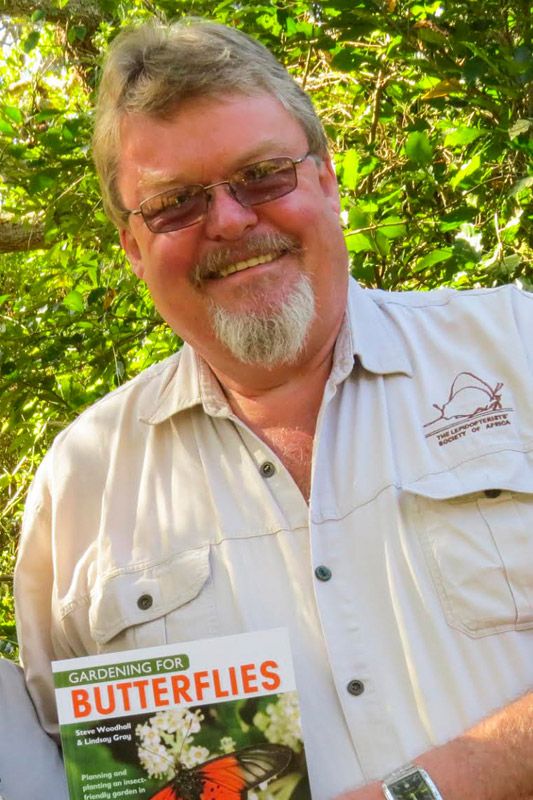
Steve Woodhall is a butterfly enthusiast and photographer who began watching and collecting butterflies at an early age. He was President of the Lepidopterists’ Society of Africa for eight years, and has contributed to and authored several books, including Field Guide to Butterfl ies of South Africa and the popular What’s that Butter fly?